Electric locomotive
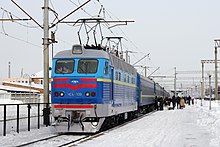
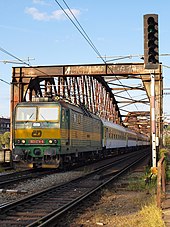

An electric locomotive is a
Electric locomotives benefit from the high efficiency of electric motors, often above 90% (not including the inefficiency of generating the electricity). Additional efficiency can be gained from
The chief disadvantage of electrification is the high cost for infrastructure: overhead lines or third rail, substations, and control systems. Public policy in the U.S. interferes with electrification: higher property taxes are imposed on privately owned rail facilities if they are electrified.[citation needed] The EPA regulates exhaust emissions on locomotive and marine engines, similar to regulations on car & freight truck emissions, in order to limit the amount of carbon monoxide, unburnt hydrocarbons, nitric oxides, and soot output from these mobile power sources.[3] Because railroad infrastructure is privately owned in the U.S., railroads are unwilling to make the necessary investments for electrification. In Europe and elsewhere, railway networks are considered part of the national transport infrastructure, just like roads, highways and waterways, so are often financed by the state.[citation needed] Operators of the rolling stock pay fees according to rail use. This makes possible the large investments required for the technically and, in the long-term, also economically advantageous electrification.
History
Direct current
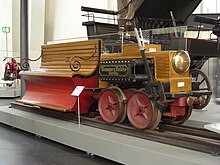
The first known electric locomotive was built in 1837 by chemist
The first electric passenger train was presented by Werner von Siemens at Berlin in 1879. The locomotive was driven by a 2.2 kW, series-wound motor, and the train, consisting of the locomotive and three cars, reached a speed of 13 km/h. During four months, the train carried 90,000 passengers on a 300-meter-long (984 feet) circular track. The electricity (150 V DC) was supplied through a third insulated rail between the tracks. A contact roller was used to collect the electricity.
The world's first electric tram line opened in Lichterfelde near Berlin, Germany, in 1881. It was built by Werner von Siemens (see
The first electrified Hungarian railway lines were opened in 1887. Budapest (See: BHÉV): Ráckeve line (1887), Szentendre line (1888), Gödöllő line (1888), Csepel line (1912).[8]
Much of the early development of electric locomotion was driven by the increasing use of tunnels, particularly in urban areas. Smoke from steam locomotives was noxious and municipalities were increasingly inclined to prohibit their use within their limits. The first electrically worked
The first use of electrification on an American main line was on a four-mile stretch of the
The Chicago, Milwaukee, St. Paul, and Pacific Railroad (the
Alternating current
The first practical
In 1894, Hungarian engineer Kálmán Kandó developed a new type 3-phase asynchronous electric drive motors and generators for electric locomotives at the Fives-Lille Company. Kandó's early 1894 designs were first applied in a short three-phase AC tramway in Évian-les-Bains (France), which was constructed between 1896 and 1898.[15][16][17][18][19] In 1918,[20] Kandó invented and developed the rotary phase converter, enabling electric locomotives to use three-phase motors whilst supplied via a single overhead wire, carrying the simple industrial frequency (50 Hz) single phase AC of the high voltage national networks.[21]
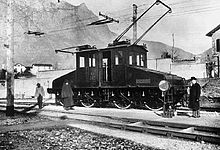
Italian railways were the first in the world to introduce electric traction for the entire length of a mainline rather than just a short stretch. The 106 km Valtellina line was opened on 4 September 1902, designed by Kandó and a team from the Ganz Works.[22][21] The electrical system was three-phase at 3 kV 15 Hz. The voltage was significantly higher than used earlier and it required new designs for electric motors and switching devices.[23][24] The three-phase two-wire system was used on several railways in Northern Italy and became known as "the Italian system". Kandó was invited in 1905 to undertake the management of Società Italiana Westinghouse and led the development of several Italian electric locomotives.[23] During the period of electrification of the Italian railways, tests were made as to which type of power to use: in some sections there was a 3,600 V 16+2⁄3 Hz three-phase power supply, in others there was 1,500 V DC, 3 kV DC and 10 kV AC 45 Hz supply. After WW2, 3 kV DC power was chosen for the entire Italian railway system.[25]
A later development of Kandó, working with both the

In Europe, electrification projects initially focused on mountainous regions for several reasons: coal supplies were difficult,
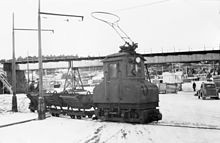
The 1960s saw the electrification of many European main lines. European electric locomotive technology had improved steadily from the 1920s onwards. By comparison, the Milwaukee Road class EP-2 (1918) weighed 240 t, with a power of 3,330 kW and a maximum speed of 112 km/h; in 1935, German E 18 had a power of 2,800 kW, but weighed only 108 tons and had a maximum speed of 150 km/h. On 29 March 1955, French locomotive CC 7107 reached 331 km/h. In 1960 the SJ Class Dm 3 locomotives on Swedish Railways produced a record 7,200 kW. Locomotives capable of commercial passenger service at 200 km/h appeared in Germany and France in the same period. Further improvements resulted from the introduction of electronic control systems, which permitted the use of increasingly lighter and more powerful motors that could be fitted inside the bogies (standardizing from the 1990s onwards on asynchronous three-phase motors, fed through GTO-inverters).
In the 1980s, the development of very high-speed service brought further electrification. The Japanese
On 2 September 2006, a standard production Siemens electric locomotive of the Eurosprinter type ES64-U4 (ÖBB Class 1216) achieved 357 km/h (222 mph), the record for a locomotive-hauled train, on the new line between Ingolstadt and Nuremberg.[29] This locomotive is now employed largely unmodified by ÖBB to haul their Railjet which is however limited to a top speed of 230 km/h due to economic and infrastructure concerns.
Types
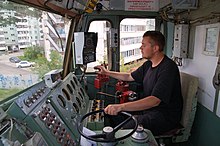
An electric locomotive can be supplied with power from
- ultracapacitor-powered mininglocomotives.
- A stationary source, such as a third rail or overhead wire.
The distinguishing design features of electric locomotives are:
- The type of electrical power used, AC or DC.
- The method of storing (batteries, ultracapacitors) or collecting (transmission) electrical power.
- The means used to couple the traction motorsto the driving wheels (drivers).
Direct and alternating current
The most fundamental difference lies in the choice of AC or DC. The earliest systems used DC, as AC was not well understood and insulation material for high voltage lines was not available. DC locomotives typically run at relatively low voltage (600 to 3,000 volts); the equipment is therefore relatively massive because the currents involved are large in order to transmit sufficient power. Power must be supplied at frequent intervals as the high currents result in large transmission system losses.
As AC motors were developed, they became the predominant type, particularly on longer routes. High voltages (tens of thousands of volts) are used because this allows the use of low currents; transmission losses are proportional to the square of the current (e.g. twice the current means four times the loss). Thus, high power can be conducted over long distances on lighter and cheaper wires. Transformers in the locomotives transform this power to a low voltage and high current for the motors.[30] A similar high voltage, low current system could not be employed with direct current locomotives because there is no easy way to do the voltage/current transformation for DC so efficiently as achieved by AC transformers.
AC traction still occasionally uses dual overhead wires instead of single-phase lines. The resulting
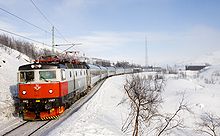
Electric traction allows the use of regenerative braking, in which the motors are used as brakes and become generators that transform the motion of the train into electrical power that is then fed back into the lines. This system is particularly advantageous in mountainous operations, as descending locomotives can produce a large portion of the power required for ascending trains. Most systems have a characteristic voltage and, in the case of AC power, a system frequency. Many locomotives have been equipped to handle multiple voltages and frequencies as systems came to overlap or were upgraded. American
While today's systems predominantly operate on AC, many DC systems are still in use – e.g., in South Africa and the United Kingdom (750 V and 1,500 V); Netherlands, Japan, Ireland (1,500 V); Slovenia, Belgium, Italy, Poland, Russia, Spain (3,000 V) and Washington, D.C. (750 V).
Power transmission
Electrical circuits require two connections (or for
Overhead lines
Railways generally tend to prefer
- Trolley pole: a long flexible pole, which engages the line with a wheel or shoe.
- Bow collector: a frame that holds a long collecting rod against the wire.
- Pantograph: a hinged frame that holds the collecting shoes against the wire in a fixed geometry.
Of the three, the pantograph method is best suited for high-speed operation. Some locomotives use both overhead and third rail collection (e.g. British Rail Class 92). In Europe, the recommended geometry and shape of pantographs are defined by standard EN 50367/IEC 60486[31]
Third rail
The original
Driving the wheels
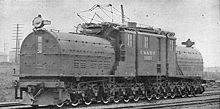
During the initial development of railroad electrical propulsion, a number of drive systems were devised to couple the output of the traction motors to the wheels. Early locomotives often used jackshaft drives. In this arrangement, the traction motor is mounted within the body of the locomotive and drives the jackshaft through a set of gears. This system was employed because the first traction motors were too large and heavy to mount directly on the axles. Due to the number of mechanical parts involved, frequent maintenance was necessary. The jackshaft drive was abandoned for all but the smallest units when smaller and lighter motors were developed,
Several other systems were devised as the electric locomotive matured. The
Another drive was the "bi-polar" system, in which the motor armature was the axle itself, the frame and field assembly of the motor being attached to the truck (bogie) in a fixed position. The motor had two field poles, which allowed a limited amount of vertical movement of the armature. This system was of limited value since the power output of each motor was limited. The EP-2 bi-polar electrics used by the Milwaukee Road compensated for this problem by using a large number of powered axles.
Modern freight electric locomotives, like their
Wheel arrangements
The
Battery locomotive
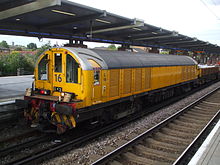
A battery-electric locomotive (or battery locomotive) is powered by onboard batteries; a kind of battery electric vehicle.
Such locomotives are used where a diesel or conventional electric locomotive would be unsuitable. An example is maintenance trains on electrified lines when the electricity supply is turned off. Another use for battery locomotives is in industrial facilities (e.g. explosives factories, oil, and gas
The first electric locomotive built in 1837 was a battery locomotive. It was built by chemist
The Toronto Transit Commission previously operated on the Toronto subway a battery electric locomotive built by Nippon Sharyo in 1968 and retired in 2009.[35]
London Underground regularly operates battery-electric locomotives for general maintenance work.
As of 2022[update], battery locomotives with 7 and 14 MWh energy capacity have been ordered by rail lines and are under development.[36]
Supercapacitor power storage
In 2020 Zhuzhou Electric Locomotive Company, manufacturers of stored electrical power systems using supercapacitors initially developed for use in trams, announced that they were extending their product line to include locomotives.[37]
Electric locomotives around the world
Europe

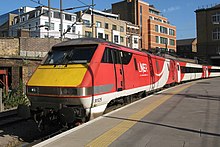
Electrification is widespread in Europe, with
Diesel locomotives have less power compared to electric locomotives for the same weight and dimensions. For instance, the 2,200 kW of a modern British Rail Class 66 diesel locomotive was matched in 1927 by the electric SBB-CFF-FFS Ae 4/7 (2,300 kW), which is lighter. However, for low speeds, the tractive effort is more important than power. Diesel engines can be competitive for slow freight traffic (as it is common in Canada and the U.S.) but not for passenger or mixed passenger/freight traffic like on many European railway lines, especially where heavy freight trains must be run at comparatively high speeds (80 km/h or more).
These factors led to high degrees of electrification in most European countries. In some countries, like Switzerland, even electric shunters are common and many private sidings are served by electric locomotives. During World War II, when materials to build new electric locomotives were not available, Swiss Federal Railways installed electric heating elements in the boilers of some steam shunters, fed from the overhead supply, to deal with the shortage of imported coal.[38][39]
Recent political developments in many European countries to enhance public transit have led to another boost for electric traction. In addition, gaps in the unelectrified track are closed to avoid replacing electric locomotives by diesel for these sections. The necessary modernization and electrification of these lines are possible, due to the financing of the railway infrastructure by the state.
British electric multiple units were first introduced in the 1890s, and current versions provide public transit and there are also a number of electric locomotive classes, such as: Class 76, Class 86, Class 87, Class 90, Class 91 and Class 92.
Russia and former USSR
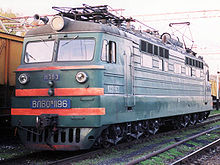
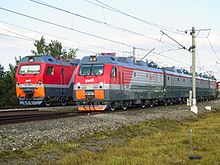
Russia and other countries of the former Soviet Union have a mix of 3,000 V DC and 25 kV AC for historical reasons.
The special "junction stations" (around 15 over the former USSR - Vladimir, Mariinsk near Krasnoyarsk, etc.) have wiring switchable from DC to AC. Locomotive replacement is essential at these stations and is performed together with the contact wiring switching.
Most Soviet, Czech (the USSR ordered passenger electric locomotives from Škoda), Russian and Ukrainian locomotives can operate on AC or DC only. For instance, VL80 is an AC machine, with VL10 a DC version. There were some half-experimental small series like VL82, which could switch from AC to DC and were used in small amounts around the city of Kharkiv in Ukraine, where is no junction station at many lines. Also, the latest Russian passenger locomotive EP20 and its half-experimental predecessor EP10 are a dual system.
Historically, 3,000 V DC was used for simplicity. The first experimental track was in the Georgian mountains, then the suburban zones of the largest cities were electrified for EMUs - very advantageous due to the much better dynamic of such a train compared to the steam one, which is important for suburban service with frequent stops. Then the large mountain line between Ufa and Chelyabinsk was electrified.
For some time, electric railways were only considered to be suitable for suburban or mountain lines. In around 1950, a decision was made (according to legend, by Joseph Stalin) to electrify the highly loaded plain prairie line of Omsk-Novosibirsk. After this, electrifying the major railroads at 3,000 V DC became mainstream.
25 kV AC started in the USSR in around 1960 when the industry managed to build the rectifier-based AC-wire DC-motor locomotive (all Soviet and Czech AC locomotives were such; only the post-Soviet ones switched to electronically controlled induction motors). The first major line with AC power was Mariinsk-Krasnoyarsk-Tayshet-Zima; the lines in European Russia like Moscow-Rostov-on-Don followed.
In the 1990s, some DC lines were rebuilt as AC to allow the usage of the huge 10 MW AC locomotive of VL85. The line around Irkutsk is one of them. The DC locomotives freed by this rebuild were transferred to the St Petersburg region.
The Trans-Siberian Railway has been partly electrified since 1929, entirely since 2002. The system is 25 kV AC 50 Hz after the junction station of Mariinsk near Krasnoyarsk, 3,000 V DC before it, and train weights are up to 6,000 tonnes.[40]
North America
Canada
Historically,
Similar to the US the flexibility of diesel locomotives and the relatively low cost of their infrastructure has led them to prevail except where legal or operational constraints dictate the use of electricity. Leading to limited electric railway infrastructure and by extension electric locomotives operating in Canada today. As of 2021, only one example exists today, GMD SW1200MG electric locomotives operated by the Iron Ore Company of Canada for a small isolated railway hauling raw ore from their Carol Lake mine to a processing plant.
In the future
United States

Electric locomotives are used for passenger trains on
In North America, the flexibility of diesel locomotives and the relatively low cost of their infrastructure have led them to prevail except where legal or operational constraints dictate the use of electricity. An example of the latter is the use of electric locomotives by Amtrak and
During the steam era, some mountainous areas were electrified but these have been discontinued. The junction between electrified and non-electrified territory is the locale of engine changes; thus Northeast Corridor trains that extend south of Washington, D.C., change locomotives there. Northeast Corridor trains used to make lengthy stops in New Haven, Connecticut, as locomotives were swapped, a delay which contributed to the decision to electrify the New Haven to Boston segment of the Northeast Corridor in 2000.[44]
Asia
China
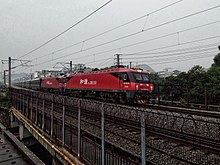
China has over 100,000 kilometres (62,000 mi) of electrified railway.[45] With most trunk line freight and long-distance passenger trains operated using high power electric locomotives, typically in excess of 7,200 kilowatts (9,700 hp) of power output. Heavy freight is hauled with extremely high power multi-section locomotives, reaching up to 28,800 kilowatts (38,600 hp) on the "Shen 24" series of six section electric locomotives.[46]
India
All mainline electrified routes in India use 25 kV AC overhead electrification at 50 Hz. As of March 2017, Indian Railways haul 85% of freight and passenger traffic with electric locomotives and 45,881 km of railway lines have been electrified.[47]
Japan
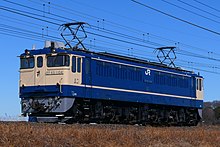

Japan has come close to complete electrification largely due to the relatively short distances and mountainous terrain, which make electric service a particularly economical investment. Additionally, the mix of freight to passenger service is weighted much more toward passenger service (even in rural areas) than in many other countries, and this has helped drive government investment into the electrification of many remote lines. However, these same factors lead operators of Japanese railways to prefer
Australia
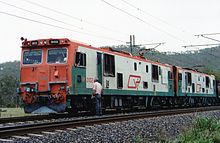
The Victorian Railways and New South Wales Government Railways, which pioneered electric traction in Australia in the early 20th century and continue to operate 1,500 V DC electric multiple units, have withdrawn their electric locomotives.
In both states, the use of electric locomotives on principal interurban routes proved to be a qualified success. In Victoria, because only the Gippsland line was electrified, the economic advantages of electric traction were not fully realized due to the need to change locomotives for trains that ran beyond the electrified network. The Victorian Railways L class were withdrawn from service by 1987,[48] and the Gippsland line electrification had been dismantled by 2004.[49]
The New South Wales 86 class locomotives introduced to NSW in 1983 had a relatively short life because the cost of maintaining the infrastructure, the need to change locomotives at the extremities of the electrified network, and higher charges levied for electricity, saw diesel locomotives take over services the electrified network.[50]
See also
- Air brake (rail)
- Baldwin-Westinghouse electric locomotives
- Battery powered railcars
- Boxcab
- Charles Grafton Page - electrical pioneer
- Electric multiple unit
- Electric-steam locomotives
- Electric vehicle battery
- Emily Davenport - electric locomotive pioneer
- Heilmann locomotive
- Hybrid train
- Railway brakes
- Railway electrification system
- Tram
References
- ^ Heilmann evaluated both AC and DC electric transmission for his locomotives, but eventually settled on a design based on Thomas Edison's DC system.[12]
- ISBN 978-0-471-36400-9.
- ^ "Electrification of U.S. Railways: Pie in the Sky, or Realistic Goal? | Article | EESI".
- ^ "EPA, Transportation and Air Quality". 16 August 2016.
- ISBN 978-0-415-06042-4.
- ^ Gordon, William (1910). "The Underground Electric". Our Home Railways. Vol. 2. London: Frederick Warne and Co. p. 156.
- ^ a b Renzo Pocaterra, Treni, De Agostini, 2003
- IEEE History Center. Archived from the originalon 2008-12-01. Retrieved 2008-01-18.
- ISBN 9635523130(1996)(English: The development of Hungarian private and state owned commuter railway companies between 1876 – 1900, Hungarian railway History Volume II.
- ISBN 978-1-85414-293-1.
- ^ B&O Power, Sagle, Lawrence, Alvin Stauffer
- ^ Duffy (2003), p. 241.
- ^ Duffy (2003), p. 39–41.
- ^ Duffy (2003), p. 129.
- ^ Duffy (2003), p. 124.
- ISBN 978-0-9665734-2-8.
Evian-les-Bains kando.
- ISBN 978-0-912404-04-2.
- ^ C.W. Kreidel (1904). Organ für die fortschritte des eisenbahnwesens in technischer beziehung. p. 315.
- ^ Elektrotechnische Zeitschrift: Beihefte, Volumes 11-23. VDE Verlag. 1904. p. 163.
- ^ L'Eclairage électrique, Volume 48. 1906. p. 554.
- ISBN 978-0-85296-805-5.
- ^ a b Hungarian Patent Office. "Kálmán Kandó (1869–1931)". www.mszh.hu. Archived from the original on 2010-10-08. Retrieved 2008-08-10.
- ^ Duffy (2003), p. 120–121.
- ^ a b "Kalman Kando". Retrieved 2011-10-26.
- ^ "Kalman Kando". Archived from the original on 2012-07-12. Retrieved 2009-12-05.
- ^ "L'esperimento a 10 Kv 45 Hz (1928–1944)". Il Mondo dei Treni.
- ^ Duffy (2003), p. 117.
- ^ Duffy (2003), p. 273–274.
- ^ a b Duffy (2003), p. 273.
- Siemens AG. 2008. Archived from the originalon June 13, 2008. Retrieved 2008-08-11.
- ^ Alternating current#Transmission, distribution, and domestic power supply
- ^ EN 50367/IEC 60486. Railway applications – Current collection systems – Technical criteria for the interaction between pantograph and overhead line (to achieve free access).
{{cite book}}: CS1 maint: numeric names: authors list (link) - ISBN 978-90-5410-915-0.
- ^ Martin, George Curtis (1919). Mineral resources of Alaska. Washington, DC: Government Printing Office. p. 144.
- ^ List of Kennecott Copper locomotives
- ^ "A Rogue's Gallery: The TTC's Subway Work Car Fleet – Transit Toronto – Content".
- ^ "Union Pacific Rail to test battery-electric locomotives". electrive.com. 31 January 2022.
- ^ Briginshaw, David (24 August 2020). "CRRC unveils super capacitor automatic LRV". International Railway Journal. Falmouth, England.
- OCLC 39200150.
- ^ Self, Douglas (December 2003). "The Swiss Electric-Steam Locomotives". Archived from the original on 2010-10-18. Retrieved 2009-08-12.
- ^ Boris DYNKIN. "Comments on the Regional Railroad Network and Power Grid Interconnection" (PDF). Archived from the original (PDF) on November 25, 2005. Retrieved 2009-05-04.
- ^ "AMT electro-diesel arrives in Montréal". www.railwaygazette.com. Archived from the original on 2012-10-03. Retrieved 2019-09-23.
- ^ "Deux-Montagnes and Mascouche lines - Transitional network from January 2020". REM. Retrieved 2019-09-23.
- ^ "Metrolinx: For a Greater Region - Going Electric". www.metrolinx.com. Retrieved 2019-09-02.
- ^ "New York to Boston, underwire - Amtrak begins all-electric Northeast Corridor service between Boston and Washington, D.C", Railway Age, March 2000, accessed from FindArticles.com on 28 Sep. 2006.
- ^ "2019 年铁道统计公报" (PDF). Archived from the original (PDF) on 2020-06-06. Retrieved 2020-06-07.
- ^ 2020-08-04T08:16:00. "28·8 MW freight locomotive unveiled". Railway Gazette International. Retrieved 2021-03-28.
{{cite web}}: CS1 maint: numeric names: authors list (link) - ^ "PLAN-WISE PROGRESS OF ELECTRIFICATION ON Indian RailwaysS". CORE. Retrieved 23 December 2017.
- Locomotives Internationalissue 108 June 2017 pages 16/17
- ^ Victorian Fast Rail Update Railway Digest May 2004 page 10
- ^ End of the 86s Railway Digest August 2002 page 32
- ^ ASEA shares Queensland loco contract Modern Railways issue 433 October 1984 page 541
Sources
- Duffy, Michael C. (2003). Electric railways, 1880-1990. Stevenage, England: The Institution of Engineering and Technology (IET). ISBN 978-0-85296-805-5.
- Haut, F.J.G. (1952). The Early History of the Electric Locomotive. Richard Tilling for the author. ASIN B0007JJNNE.
- Haut, F.J.G. (1969). The History of the Electric Locomotive. London: George Allen and Unwin Ltd. ISBN 978-0-04-385042-8.
- Haut, F.J.G. (1970). The Pictorial History of Electric Locomotives (1st ed.). Oak Tree Publications. ISBN 978-0-498-07644-2.
- Haut, F.J.G. (1970). A History of the Electric Locomotive, Volume Two (1st ed.). South Brunswick, NJ: ISBN 978-0-498-02466-5.
- Haut, F.J.G. (1977). Electric locomotives of the World. Barton. ISBN 978-0-85153-256-1.
- Haut, F.J.G. (1981). A History of the Electric Locomotive. Volume 2. ASIN B000RAWB64.
- Haut, F.J.G. (1987). A History of the Electric Locomotive, Vol. 2: Railcars and the Industrial Locomotive. ISBN 978-0-498-02466-5.
